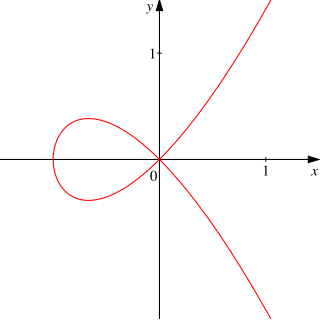
Algebraic geometry is a branch of mathematics which uses abstract algebraic techniques, mainly from commutative algebra, to solve geometrical problems. Classically, it studies zeros of multivariate polynomials; the modern approach generalizes this in a few different aspects.

In algebraic geometry and commutative algebra, the Zariski topology is a topology which is primarily defined by its closed sets. It is very different from topologies which are commonly used in real or complex analysis; in particular, it is not Hausdorff. This topology was introduced primarily by Oscar Zariski and later generalized for making the set of prime ideals of a commutative ring a topological space.

In mathematics, an algebraic group is an algebraic variety endowed with a group structure that is compatible with its structure as an algebraic variety. Thus the study of algebraic groups belongs both to algebraic geometry and group theory.
In mathematics, the adele ring of a global field is a central object of class field theory, a branch of algebraic number theory. It is the restricted product of all the completions of the global field and is an example of a self-dual topological ring.

Algebraic varieties are the central objects of study in algebraic geometry, a sub-field of mathematics. Classically, an algebraic variety is defined as the set of solutions of a system of polynomial equations over the real or complex numbers. Modern definitions generalize this concept in several different ways, while attempting to preserve the geometric intuition behind the original definition.
In mathematics, a global field is one of two types of fields which are characterized using valuations. There are two kinds of global fields:

In algebraic geometry, an affine algebraic set is the set of the common zeros over an algebraically closed field k of some family of polynomials in the polynomial ring An affine variety or affine algebraic variety, is an affine algebraic set such that the ideal generated by the defining polynomials is prime.
In mathematics, a scheme is a mathematical structure that enlarges the notion of algebraic variety in several ways, such as taking account of multiplicities and allowing "varieties" defined over any commutative ring.
In mathematics, the Tamagawa number of a semisimple algebraic group defined over a global field k is the measure of , where is the adele ring of k. Tamagawa numbers were introduced by Tamagawa (1966), and named after him by Weil (1959).
In algebraic geometry, divisors are a generalization of codimension-1 subvarieties of algebraic varieties. Two different generalizations are in common use, Cartier divisors and Weil divisors. Both are derived from the notion of divisibility in the integers and algebraic number fields.
Continuation of the Séminaire Nicolas Bourbaki programme, for the 1950s.
In mathematics, the Weil conjecture on Tamagawa numbers is the statement that the Tamagawa number of a simply connected simple algebraic group defined over a number field is 1. In this case, simply connected means "not having a proper algebraic covering" in the algebraic group theory sense, which is not always the topologists' meaning.

Angus John Macintyre FRS, FRSE is a British mathematician and logician who is a leading figure in model theory, logic, and their applications in algebra, algebraic geometry, and number theory. He is Emeritus Professor of Mathematics, at Queen Mary University of London.
In mathematics, the field with one element is a suggestive name for an object that should behave similarly to a finite field with a single element, if such a field could exist. This object is denoted F1, or, in a French–English pun, Fun. The name "field with one element" and the notation F1 are only suggestive, as there is no field with one element in classical abstract algebra. Instead, F1 refers to the idea that there should be a way to replace sets and operations, the traditional building blocks for abstract algebra, with other, more flexible objects. Many theories of F1 have been proposed, but it is not clear which, if any, of them give F1 all the desired properties. While there is still no field with a single element in these theories, there is a field-like object whose characteristic is one.
In mathematics, the Artin conductor is a number or ideal associated to a character of a Galois group of a local or global field, introduced by Emil Artin as an expression appearing in the functional equation of an Artin L-function.
This is a glossary of algebraic geometry.
In mathematics, a ray class field is an abelian extension of a global field associated with a ray class group of ideal classes or idele classes. Every finite abelian extension of a number field is contained in one of its ray class fields.
In mathematics, class field theory is the study of abelian extensions of local and global fields.
Basic Number Theory is an influential book by André Weil, an exposition of algebraic number theory and class field theory with particular emphasis on valuation-theoretic methods. Based in part on a course taught at Princeton University in 1961-2, it appeared as Volume 144 in Springer's Grundlehren der mathematischen Wissenschaften series. The approach handles all 'A-fields' or global fields, meaning finite algebraic extensions of the field of rational numbers and of the field of rational functions of one variable with a finite field of constants. The theory is developed in a uniform way, starting with topological fields, properties of Haar measure on locally compact fields, the main theorems of adelic and idelic number theory, and class field theory via the theory of simple algebras over local and global fields. The word `basic’ in the title is closer in meaning to `foundational’ rather than `elementary’, and is perhaps best interpreted as meaning that the material developed is foundational for the development of the theories of automorphic forms, representation theory of algebraic groups, and more advanced topics in algebraic number theory. The style is austere, with a narrow concentration on a logically coherent development of the theory required, and essentially no examples.










